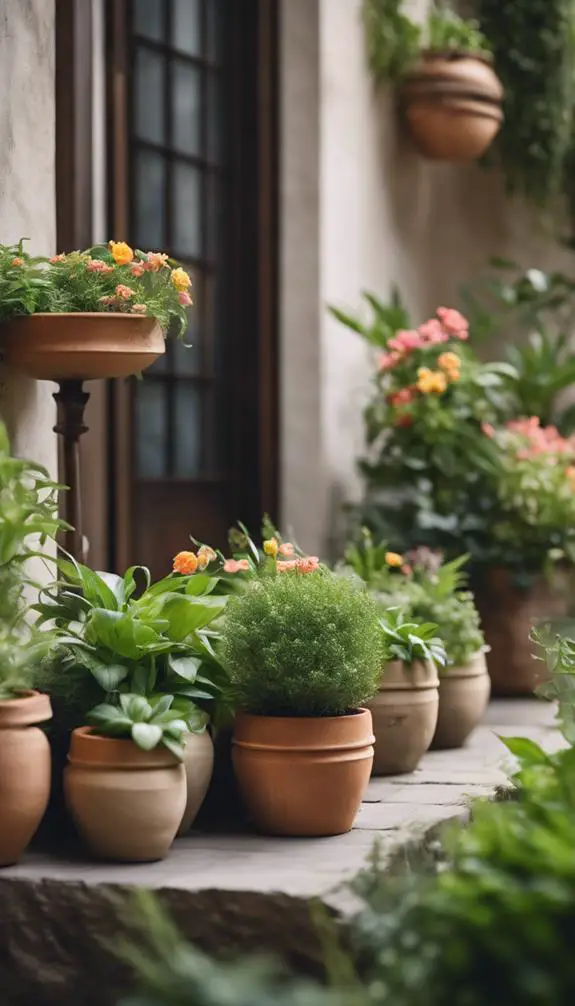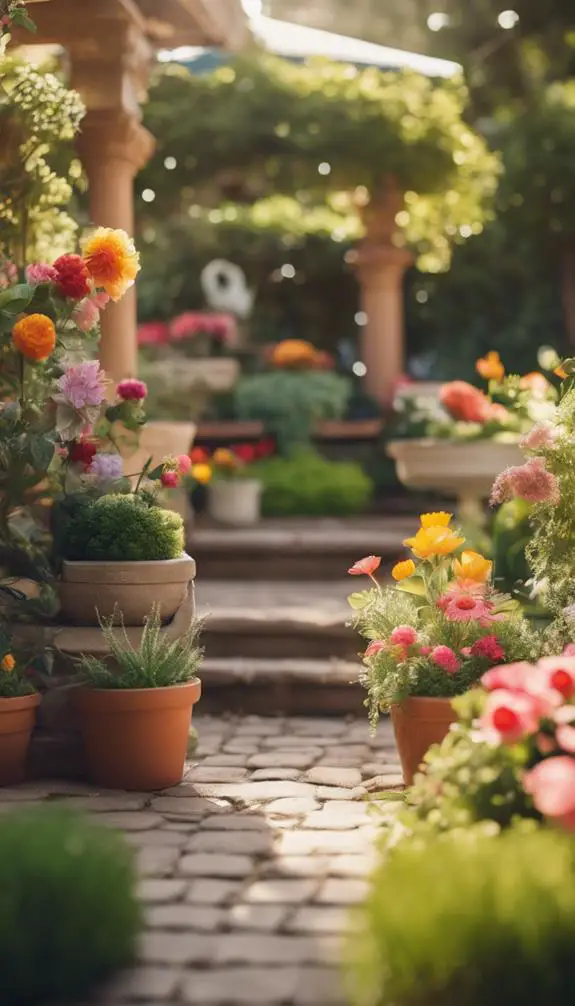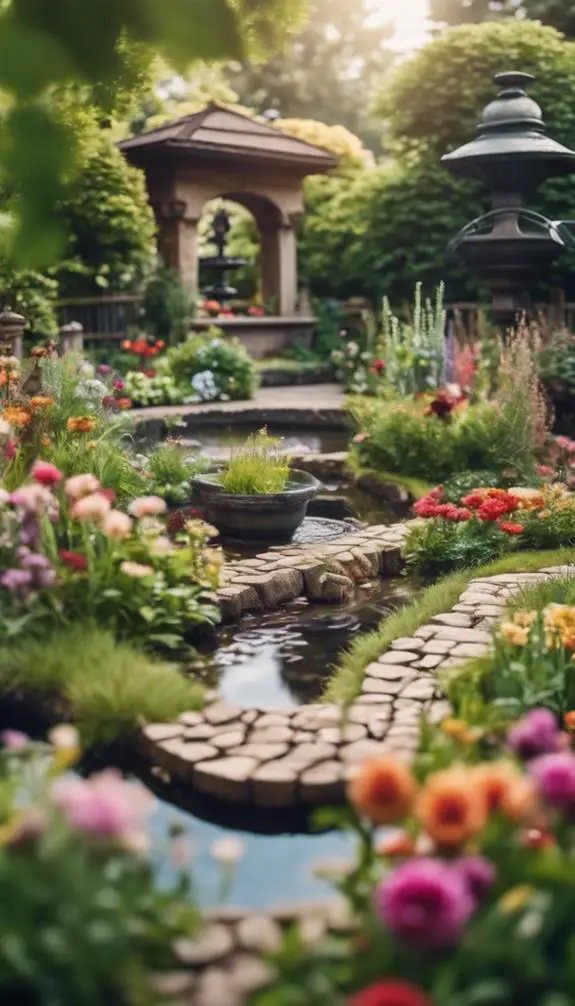As you set out on designing a small garden layout for your container garden, you'll quickly realize that making the most of your limited space is key. You'll need to carefully select containers that fit your area's unique constraints, while also ensuring they provide proper drainage and are suitable for your local climate. But that's just the beginning – you'll also want to think about how to create a visually appealing display that draws the eye and creates a sense of harmony. And that's where things get really interesting – stay tuned to learn how to turn your small space into a stunning oasis.
Summary
- Measure the yard to determine space constraints and set realistic goals for the container garden's layout and design.
- Choose containers that maximize space, ensure proper drainage, and consider sustainable options to reduce environmental footprint.
- Select plants that thrive in the local climate, have low maintenance requirements, and fit the specific conditions of the small garden.
- Create a visually appealing display by grouping containers effectively, clustering them, and balancing large with small ones.
- Optimize space by using corner accents, layering plants, and creating visual layers with containers of varying heights and depths.
Assessing Your Space Constraints

Frequently, small garden layouts are born out of necessity, as homeowners are forced to get creative with the limited space they've available.
You'll need to assess your space constraints by measuring the length, width, and any obstacles in your yard. Take note of the amount of sunlight your space receives and any existing features like trees, slopes, or patios.
This information will help you determine the boundaries of your garden, allowing you to set realistic goals for your space planning. By setting these boundaries, you'll be able to visualize your garden's potential and make the most of every inch.
Effective boundary setting enables you to create a functional and beautiful container garden that thrives within its limitations.
Selecting the Right Containers
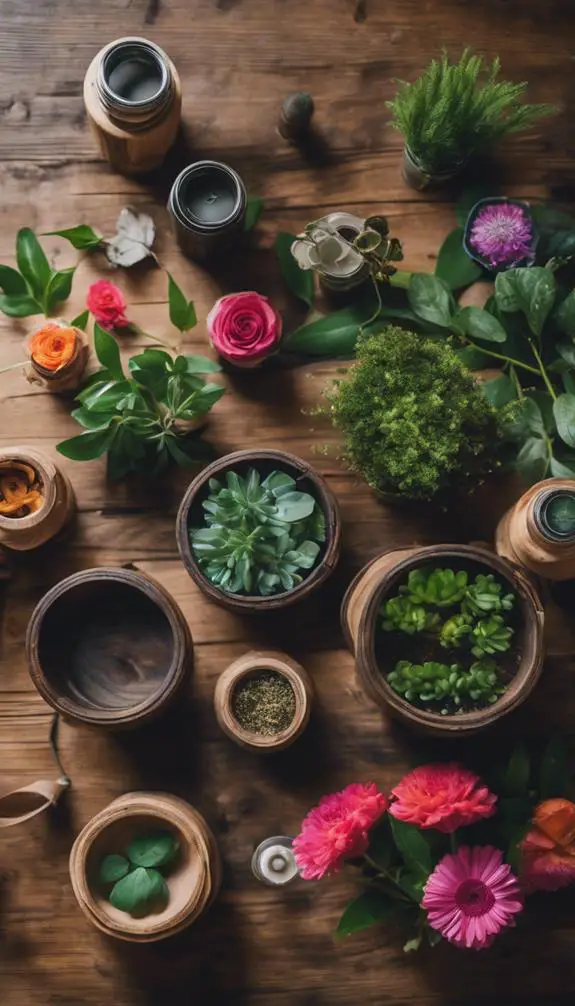
When selecting containers for your small garden, you'll want to choose the right size to maximize space without overwhelming the area.
Consider the material options available, from sleek modern metal to rustic wooden planters, and think about how they'll complement your garden's style.
Don't forget that proper drainage is essential to prevent waterlogged soil and root rot, so look for containers with built-in drainage holes or consider adding a drainage layer.
Choose the Right Size
You're standing in front of your small garden, envisioning a beautiful oasis, but first, you need to decide on the right containers.
The key is to choose a container size that complements your garden's proportions. Consider the space available and the mature size of the plants you'll be growing.
A good rule of thumb is to select containers that are at least 5-7 gallons for small to medium-sized plants. For larger plants, you may need containers that are 10-15 gallons or more.
Consider Material Options
With your container size in mind, it's time to think about the material that will best showcase your plants.
When it comes to material selection, you've got plenty of options. Traditional choices like ceramic, terracotta, or wood can add a rustic touch, while modern materials like metal, fiberglass, or resin can provide a sleek, contemporary look.
Consider sustainable options like recycled plastic or repurposed materials to reduce your environmental footprint. Think about durability, weight, and maintenance when making your decision.
Will your containers be exposed to harsh weather or heavy use? Choose materials that can withstand the elements and last for seasons to come.
Drainage Is Essential
Pick containers that let water drain freely to prevent waterlogged soil and root rot.
You want to guarantee your plants receive the right amount of moisture without drowning them.
Containers with drainage holes are a must-have for a thriving container garden.
These holes allow excess water to escape, preventing waterlogged soil that can lead to root rot and other problems.
As you select your containers, look for ones with built-in drainage holes or consider adding your own.
You can drill holes in the bottom of the container or add a layer of small rocks or broken pottery to facilitate drainage.
Choosing Low-Maintenance Plants
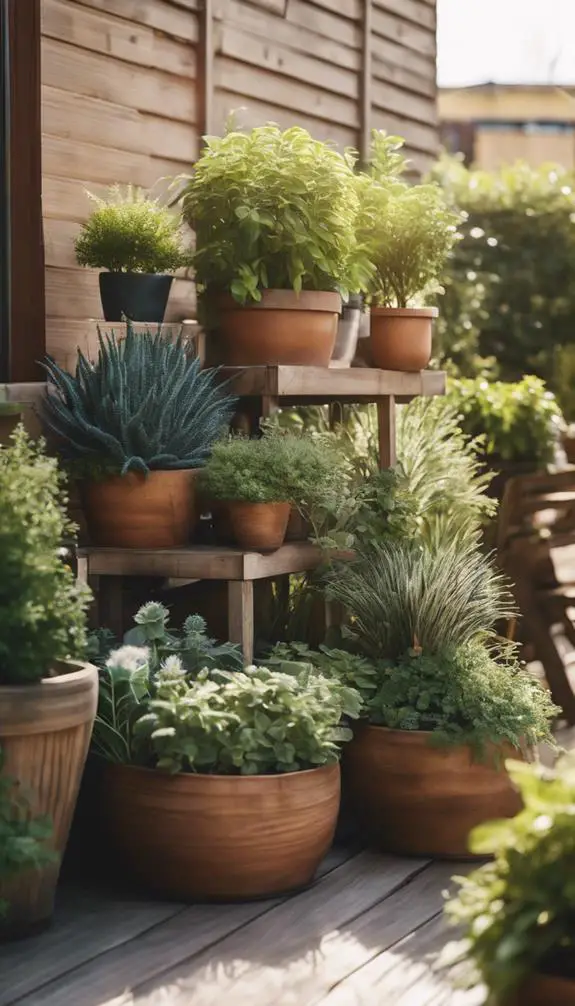
Selecting the right plants for your small garden is crucial, as they'll be the stars of the show.
When choosing low-maintenance plants, consider their Plant Hardiness – can they thrive in your local climate? You'll also want to think about Soil Preferences – do they need well-draining soil or can they tolerate moisture?
Succulents and cacti are great options, as they're adapted to store water and require infrequent watering. Herbs like basil and mint are also low-fuss, and can add fresh flavor to your cooking.
Look for plants that fit your lifestyle and the specific conditions of your small garden. By doing so, you'll create a beautiful, thriving space that requires minimal upkeep.
Considering Sunlight and Shade
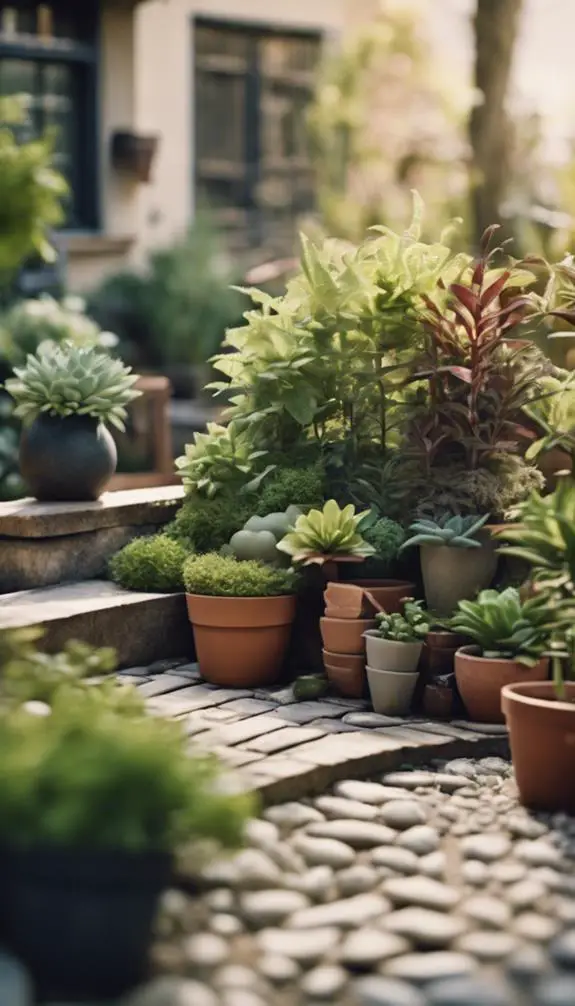
You'll want to take stock of your garden's morning sun exposure, as this will impact which plants thrive in each area.
Consider which spots receive direct sunlight and which are shaded, as this will influence your plant choices and overall layout.
Morning Sun Exposure
As morning sunbeams creep over your small garden, they bring new life to the landscape.
This is the perfect time to capitalize on the gentle warmth and light by creating a sunlit nook. Plant morning glories in containers that receive direct morning sun, and watch them unfurl their trumpet-shaped flowers in shades of blue, purple, and pink.
These climbing vines will thrive in the morning sun, providing a beautiful backdrop for your container garden. Consider placing a bench or seating area in this spot to create a peaceful retreat where you can bask in the morning sun's warmth.
Shady Areas Considered
Shifting your focus to the shady areas of your small garden, you'll discover a world of opportunities to create a unique and enchanting space.
Shady nooks, often overlooked, can become tranquil retreats for shade seekers. Consider the dappled light filtering through trees or the soft glow beneath a pergola.
These areas can host a variety of plants that thrive in low-light conditions, such as ferns, impatiens, and coleus. By incorporating shade-tolerant plants and creative container arrangements, you can craft an intimate, mystical ambiance.
Don't neglect these hidden gems – instead, transform them into mesmerizing focal points that add depth and visual interest to your small garden.
Creating a Focal Point
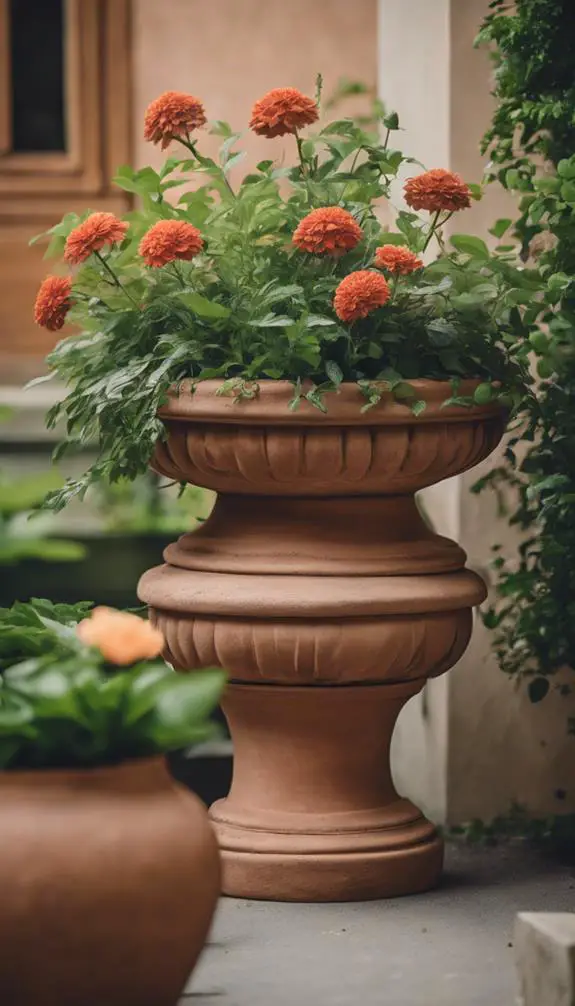
What draws your eye to a particular spot in a garden?
A well-designed focal point does just that. It's a visual anchor that captures attention and creates a sense of cohesion in your container garden.
To create a central statement, choose a striking element, like a bold-colored pot, a sculptural piece, or a show-stopping plant.
Place it in a prominent location, like the center of a grouping or at the end of a visual pathway.
This visual anchor will draw the eye and create a sense of harmony in your small garden layout.
Balancing Color and Texture

Creating a visually appealing small garden layout involves carefully balancing color and texture to engage the viewer's eye.
You'll want to achieve color harmony by selecting a palette that works together. Consider monochromatic, analogous, or complementary color schemes to create visual interest.
Don't forget about texture contrast – combining smooth, rough, and soft elements will add depth to your design. For example, pair velvety-leaved plants with prickly succulents or rough-barked trees.
By thoughtfully balancing color and texture, you'll create an enthralling container garden that invites exploration. Remember, it's all about striking a balance – too much of one thing can overwhelm the senses.
Experiment with different combinations to find the perfect harmony for your small garden layout.
Using Vertical Space Wisely

As you've carefully balanced color and texture, now it's time to maximize your small garden's potential by making the most of its vertical space.
You can do this by incorporating space-saving elements that draw the eye upward. Vertical trellises are a great option, providing support for climbing plants like ivy, clematis, or morning glories.
These space savers not only add visual interest but also create a sense of depth and height, making your small garden feel more expansive. Consider using wall-mounted planters, arbors, or obelisks to further utilize your garden's vertical space.
Incorporating Themed Elements
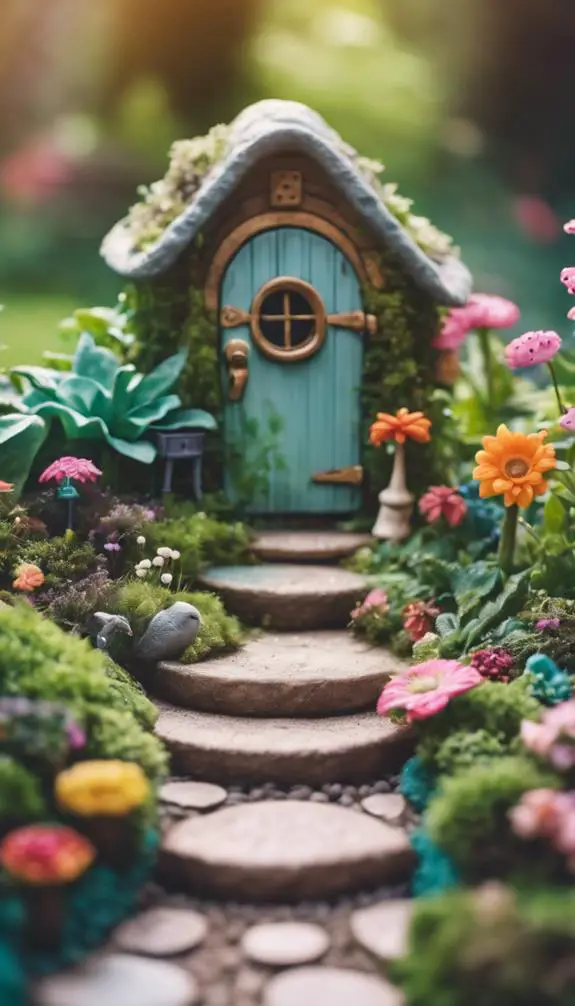
You've carefully crafted your small garden's layout, balancing color and texture while maximizing vertical space.
Now it's time to incorporate themed elements that reflect your personality and style. Add whimsy elements like a miniature lighthouse, seashells, or driftwood to evoke Coastal vibes.
These decorative accents will transport you to a seaside oasis, even in a small urban space. Consider adding a statement piece, like a vintage anchor or a nautical-themed planter, to anchor the theme.
Grouping Containers Effectively
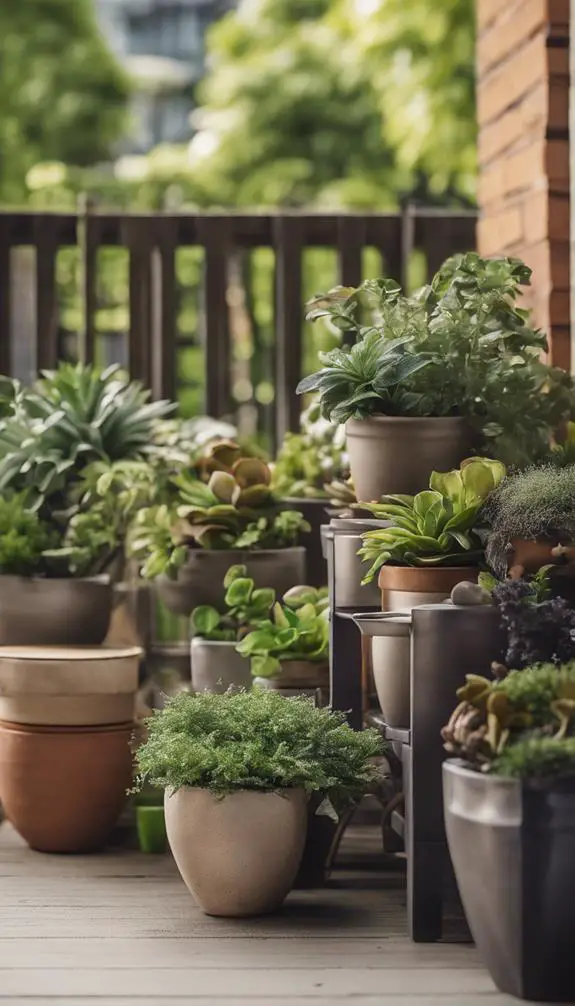
Three to five containers of varying sizes and shapes can work together to create a visually appealing display in your small garden.
By clustering containers, you can create a sense of harmony and visual interest. Consider grouping containers of similar shapes or textures together, or mix and match different styles to add contrast.
To achieve a harmonious grouping, balance large containers with smaller ones, and combine tall, upright plants with trailing or spreading varieties. Container clustering allows you to create a dynamic, ever-changing display that adds depth and dimension to your small garden.
Experiment with different arrangements to find the perfect combination that suits your style and space.
Adding Decorative Accents

Frequently, a small garden's visual appeal is elevated by the strategic placement of decorative accents.
You can use garden ornaments like statues, bird baths, or sundials to create focal points and add personality to your space.
Pottery pieces, such as colorful vases or planters, can also be used to add visual interest. Consider grouping them together to create a unique vignette or scatter them throughout the garden to create a sense of movement.
Remember to balance the accents with the containers and plants to avoid overwhelming the space. By thoughtfully incorporating decorative accents, you can create a visually stunning and inviting container garden that reflects your personal style.
Maximizing Corner Spaces

As you design your small garden layout, you're likely to encounter corners that can be challenging to utilize.
Corner Plant Placement
By cleverly utilizing the often-wasted space in corners, you can substantially boost the overall visual appeal and functionality of your small garden.
Corner accents can add a touch of elegance, drawing the eye to these hidden corners. Consider placing a statement piece, like a showy planter or a dramatic sculpture, in a corner to create a focal point.
Alternatively, use trailing plants or vines to spill over the edges of a corner, softening the hard lines and creating a sense of movement.
Space-Saving Designs
You've cleverly utilized the corner spaces with plants and accents, now it's time to maximize their functionality with space-saving designs.
Create a sense of depth by layering plants of varying heights and textures. Install a trellis or an obelisk to train vines or climbing plants, making the most of vertical space.
Consider using corner planters with built-in shelves or pockets to hold small pots, increasing space efficiency. By incorporating these designs, you'll create an urban oasis that's both visually appealing and functional.
With every inch optimized, your small garden will feel more expansive, inviting you to relax and unwind amidst the lush surroundings.
Creating a Sense of Depth

Beyond the boundaries of your small garden's physical space, lies an opportunity to create an illusion of grandeur through clever design.
You can create visual layers by placing containers of varying heights and depths, generating an optical illusion that makes your garden appear larger.
Position taller containers towards the back, and shorter ones towards the front, to create a sense of depth. This technique will draw the eye through the garden, creating an illusion of space.
Additionally, use plants with varying textures, colors, and shapes to add visual interest and create a sense of dimensionality.
Maintaining Your Container Garden

Containers need regular maintenance to thrive, and neglecting this crucial step can lead to a decline in plant health and aesthetics.
You'll want to establish a consistent watering schedule to guarantee your plants receive the right amount of moisture. Check the soil daily, and water when it feels dry to the touch. Be mindful of overwatering, which can lead to root rot and other issues.
Additionally, keep an eye out for pests like aphids, whiteflies, and spider mites. Use organic pest control methods whenever possible, such as neem oil or insecticidal soap. Regularly inspect your plants for signs of infestation, and take action quickly to prevent the problem from spreading.
FAQs
How Often Should I Rotate My Containers for Even Plant Growth?
You'll want to rotate your containers every 1-2 weeks to guarantee even plant growth, as root bound plants can become lopsided from uneven sunlight exposure; this rotation trick will keep your plants thriving and symmetrical.
Can I Use Containers With No Drainage Holes?
You can use containers with no drainage holes, but be cautious: without overflow protection, water logging can occur, causing root rot. Add a layer of small rocks or broken pottery to facilitate drainage and prevent waterlogged soil.
What Is the Ideal Soil Depth for Container Gardens?
You'll want to aim for a soil depth of at least 5-7 inches in your containers, allowing for a balanced soil structure and proper water penetration, while also considering your soil's pH level to guarantee peak plant growth.
How Do I Prevent Pests From Spreading Between Containers?
You prevent pests from spreading between containers by using pest barriers, like fine mesh or copper tape, and incorporating companion planting, where certain plants repel pests, to create a protective environment that keeps unwanted critters at bay.
Can I Grow Vegetables and Flowers Together in the Same Container?
You can create a stunning mixed harvest by combining veggies and flowers in one container using companion planting! Marigolds repel nematodes, while basil and tomatoes make perfect pairs, attracting beneficial insects and enhancing flavors. Experiment and enjoy the synergy!
Conclusion
You've successfully designed a small garden layout for your container garden! With a thoughtful plan, you've maximized space, guaranteed proper drainage, and selected plants that thrive in your climate. Your visually appealing display is now complete, with a focal point drawing the eye and a sense of depth created through strategic container placement. Enjoy the beauty and serenity your container garden brings to your outdoor space!


